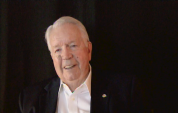3:42 | Jim Starnes describes the battleship Missouri's mission to bombard Japanese installations on Hokkaido. He became the navigator for entire fleet, in effect, because they were all following the flagship. (This interview made possible with the support of COL ROBERT W. RUST, USMCR (ret.) in honor of LtGen Lawrence Snowden & LtGen George Christmas.)
Keywords : Jim Starnes navigator USS Missouri (BB-63) Hokkaido Japan bombardment 3rd Fleet Stuart Murray

Influenced by a friend who had joined the Navy, Jim Starnes decided to do the same and take advantage of the V-7 Navy College Training Program. It was a plan instituted in 1940 to train midshipmen for the expanding fleet of ships. A one month cruise started the training, followed by three months of intense schooling. (This interview made possible with the support of COL ROBERT W. RUST, USMCR (ret.) in honor of LtGen Lawrence Snowden & LtGen George Christmas.)
Jim Starnes was a young assistant navigator on the USS Boise, a cruiser out of Pearl Harbor. The ship was not there when the Japanese attack happened. They were in the Philippines on an escort mission. The men of the Boise got a short command telling them they were at war, but it was days before they knew why. (This interview made possible with the support of COL ROBERT W. RUST, USMCR (ret.) in honor of LtGen Lawrence Snowden & LtGen George Christmas.)
It had been decided the Japanese supply routes must be disrupted. Jim Starnes describes the daring decoy mission that was given to the USS Boise to distract the Japanese forces further south. Then, the cruiser headed for the Mediterranean, where it participated in the bombardment for the Sicily and Salerno landings. (This interview made possible with the support of COL ROBERT W. RUST, USMCR (ret.) in honor of LtGen Lawrence Snowden & LtGen George Christmas.)
It had been decided that the Tokyo Express must be disrupted. That was the name given to the Japanese supply convoys reinforcing Guadalcanal. On board the cruiser USS Boise, Jim Starnes knew that his was the only ship outfitted with a new radar system, which gave them a real advantage. Unfortunately, it did not stop the enemy shells. (This interview made possible with the support of COL ROBERT W. RUST, USMCR (ret.) in honor of LtGen Lawrence Snowden & LtGen George Christmas.)
He was ordered back to the States and he didn't know why, but soon Jim Starnes found out. Apparently, he was such a good navigator that the Navy wanted him running the navigator school in Newport. So many ships were being commissioned that crews had to be swiftly prepared to man them. (This interview made possible with the support of COL ROBERT W. RUST, USMCR (ret.) in honor of LtGen Lawrence Snowden & LtGen George Christmas.)
He was only a lieutenant, but the Navy had decided that you could be navigator with that rank, so Jim Starnes was the new navigator on board the USS Missouri, Admiral Halsey's flagship. The nearly new battleship took part in the bombardment of Iwo Jima and Okinawa and came under kamikaze attack. (This interview made possible with the support of COL ROBERT W. RUST, USMCR (ret.) in honor of LtGen Lawrence Snowden & LtGen George Christmas.)
The news of the atomic bomb strikes was huge for Jim Starnes aboard the USS Missouri. The war was finally going to come to an end. Then came more news. The Missouri would be host to the surrender ceremony and, as officer of the deck, it would be his responsibility to make sure it went smoothly. (This interview made possible with the support of COL ROBERT W. RUST, USMCR (ret.) in honor of LtGen Lawrence Snowden & LtGen George Christmas.)
After the war, Jim Starnes saw an ad in Life magazine from Bell Laboratories touting it's radar components, which enabled his ship, the USS Boise, to sink six Japanese warships. He reads that ad and then reads a poem written by a Navy captain that was brought to light by Admiral Chester Nimitz. (This interview made possible with the support of COL ROBERT W. RUST, USMCR (ret.) in honor of LtGen Lawrence Snowden & LtGen George Christmas.)